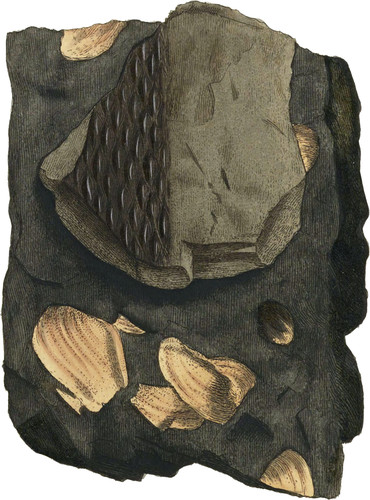 Enlarge
Enlarge
British Mineralogy
Coal Shale
- Syn.
- Schieffer Thon. Werner.
- Shale and Stourbridge Clay. Kirw. 1. 182.
- Clunch and shale. Farey, Derbysh. report, pp. 161, 180, and 443.
- Shale and Indurated Clay. Aikins manual, 241 and 242.
One of the principal rocks that accompanies Coal is the Slate-Clay or Shale; it differs from Slate (Clay-slate), to which sometimes it bears a great resemblance, in the imperfection of its laminæ, and in falling to pieces when exposed to the vicissitudes of wet and dry, producing a kneadable Clay. The varieties are many, some of them are nearly pure Alumine; others contain much Silex and sometimes grains of Mica; those containing most alumine are nearly infusible, and, therefore, fitted for fire bricks and lute, that will stand the intense heat required for smelting Iron and other refractory ores; those are providentially placed as if to point out their uses, immediately beneath the fuel; one of the best kinds is called Stourbridge Clay, it is coloured grey by Bitumen, therefore burns nearly white, audit readily falls to pieces when wetted; oilier kinds, more strictly termed Shale, do not fall to pieces until exposed to the weather, such contain more silex and are proportionally more fusible: several of them also hold Bitumen enough to reader them inflammable. Thin layers of Bituminous coal often occur in strata of Shale, and the larger strata of Coal are bounded by and include layers of Shale, fragments of which are too often brought to London among the coals; if these elates, as they are called, find their way into the fire, they prove troublesome by stopping the draught, otherwise, if kept rod hot they radiate much heat and consume slowly. All the strata contain Ferns, the steins of large reeds or gigantic plants, similar to Euphorbiæ, Cacti, &c. converted into Bituminous Coal; these are much more numerous in some parts of strata than in others; some of the stems are horizontal and compressed; others are vertical and cylindrical, and both are often filled with argillaceous Ironstone, see tab. 61. Nodules and beds of this latter are the most valuable products of this Shale, particularly when they occur in the vicinity of good coal, as in Staffordshire, where the same pit often affords both. Shells sometimes occur; those I have met with are of Lamarckes Genus Unio and are figured Min. Con. t. 33. these are often filled with Ironstone. Shale alternates with several kinds of Sandstone, many of which partake more or less of the nature of Shale; some indeed seem to be little else than a mixture of it, with fine sand and a little Mica, while others are a pure sand containing layers of Mica; such is the Yorkshire paving stone. The former are termed Blue post, Binds, &c. and the latter White post, Grits, &c. most of them have a few vegetable impressions and specks of Coal.
The upper figure shows the common and lighter appearance: the other is varied, with a more coaly aspect, and has the impression of Shells about it, with the shining or Slick en side appearance in bread masses: it is from a specimen by favour of Mr. Farey, who brought it from Scotland. I have such from Nottingham long since, by the attention of a long lost friend, as well as from other places, which shows it to be common in several Coalfields.

